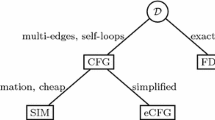Abstract
The paper is dealing with estimation of rare event probabilities in stochastic networks. The well known variance reduction technique, called Importance Sampling (IS) is an effective tool for doing this. The main idea of IS is to simulate the random system under a modified set of parameters, so as to make the occurrence of the rare event more likely. The major problem of the IS technique is that the optimal modified parameters, called reference parameters to be used in IS are usually very difficult to obtain. Rubinstein (Eur J Oper Res 99:89–112, 1997) developed the Cross Entropy (CE) method for the solution of this problem of IS technique and then he and his collaborators applied this for estimation of rare event probabilities in stochastic networks with exponential distribution [see De Boer et al. (Ann Oper Res 134:19–67, 2005)]. In this paper, we test this simulation technique also for medium sized stochastic networks and compare its effectiveness to the simple crude Monte Carlo (CMC) simulation. The effectiveness of a variance reduction simulation algorithm is measured in the following way. We calculate the product of the necessary CPU time and the estimated variance of the estimation. This product is compared to the same for the simple Crude Monte Carlo simulation. This was originally used for comparison of different variance reduction techniques by Hammersley and Handscomb (Monte Carlo Methods. Methuen & Co Ltd, London, 1967). The main result of the paper is the extension of CE method for estimation of rare event probabilities in stochastic networks with beta distributions. In this case the calculation of reference parameters of the importance sampling distribution requires numerical solution of a nonlinear equation system. This is done by applying a Newton–Raphson iteration scheme. In this case the CPU time spent for calculation of the reference parameter values cannot be neglected. Numerical results will also be presented.
Similar content being viewed by others
References
Asmussen S, Rubinstein RY (1995) Steady state rare events simulation in queueing models and its complexity properties. In: Advances in queueing: theory, methods and open problems. CRC Press, Boca Raton, pp 429–461
Deák I (2001) Computer experiences with successive regression approximations for solving equations. In: Gianessi F, Pardalos P, Rapcsk T Optimization theory. Kluwer, Dordrecht, pp 65–80
Deák I (2002) Computing two-stage stochastic programming problems by successive regression approximations. In: Marti K(eds) Stochastic Optimizatin techniques—numerical methods and technical applications, LNEMS, vol 513. Springer, Heidelberg, pp 91–102
De Boer PT (2000) Analysis and efficient simulation of queueing models of telecommunication systems. Ph.D. Thesis, University of Twente
De Boer PT, Kroese DP, Rubinstein RY (2002) A fast cross entropy method for estimating buffer overflows in queueing networks. In: Fourth workshop on rare event simulation and related combinatorial optimization problems, RESIM/COP
De Boer PT, Kroese DP, Mannor S, Rubinstein RY (2005) A tutorial on the cross entropy method. Ann Oper Res 134: 19–67
De Boer PT, Nicola VF, Rubinstein RY (2000) Adaptive importance sampling simulation of queueing networks. In: Proceedings of the 2000 winter simulation conference. Orlando, pp 646–655
Fábián CI, Szőke Z (2007) Solving two-stage stochastic programming problems with level decomposition. Comput Manag Sci 4: 313–353
Garvels MJJ (2000) The splitting method in rare event simulation. Ph.D. Thesis, University of Twente
Hammersley JM, Handscomb DC (1967) Monte carlo methods. Methuen & Co Ltd, London
Homem-de-Mello T, Rubinstein RY (2002a) Rare event probability estimation for static models via cross-entropy and importance sampling (submitted)
Homem-de-Mello T, Rubinstein RY (2002b) Estimation of rare event probabilities using cross-entropy. In: Yucesan E, Chen C-H, Snowdon JL, Charnes JM (eds) Proceedings of the 2002 winter simulation conference
Keith J, Kroese DP (2002) Sequence alignment by rare event simulation. In: Yucesan E, Chen C-H, Snowdon JL, Charnes JM (eds) Proceedings of the 2002 winter simulation conference, pp 320–327
Kleijnen JPC, Rubinstein RY (1996) Optimization and sensitivity analysis of computer simulation models by the score function method. Eur J Oper Res 88: 413–427
McLachlan G, Krishnan T (1997) The EM algorithm and extensions. Wiley, New York
Lieber D, Rubinstein RY, Elmakis D (1997) Quick estimation of rare events in stochastic networks. IEEE Trans Reliab 46(2): 254–265
Prékopa A (1995) Stochastic programming. Kluwer, Dordrecht
Prékopa A, Long J, Szántai T (2003) New bounds and approximations for the probability distribution of the length of the critical path. In: Marti K, Ermoliev Y, Pflug G(eds) Lecture notes in economics and mathematical systems. Dynamic stochastic optimization, vol 532. Springer, Berlin, pp 293–320
Rubinstein RY (1997) Optimization of computer simulation models with rare events. Eur J Oper Res 99: 89–112
Rubinstein RY (1999) The Cross-Entropy method for combinatorial and continuous optimization. Methodol Comput Appl Probab 1: 127–190
Rubinstein RY (2001) Combinatorial optimization, cross-entropy, ants and rare events. In: Uryasev S, Pardalos PM(eds) Stochastic optimization: algorithms and applications. Kluwer, Dordrecht, pp 304–358
Rubinstein RY (2002) Cross-entropy and rare events for maximal cut and partition problems. ACM Trans Model Comput Simul 12(1): 27–53
Rubinstein RY, Kroese D (2002) Lecture notes on the cross-entropy method (manuscript)
Rubinstein RY, Melamed B (1998) Modern simulation and modeling. Wiley, New York
Rubinstein RY, Shapiro A (1993) Discrete event systems: sensitivity analysis and stochastic optimization via the score function method. Wiley, New York
Shahabuddin P (1995) Rare Event Simulation of Stochastic Systems. In: Proceedings of the 1995 winter simulation conference. IEEE Press, Washington DC, pp 178–185
Author information
Authors and Affiliations
Corresponding author
Additional information
This work was supported by grant from the Hungarian National Scientific Research Grant OTKA T047340.
Rights and permissions
About this article
Cite this article
Gouda, A.A., Szántai, T. Rare event probabilities in stochastic networks. Cent Eur J Oper Res 16, 441–461 (2008). https://doi.org/10.1007/s10100-008-0068-9
Published:
Issue Date:
DOI: https://doi.org/10.1007/s10100-008-0068-9




